15-Year Analysis of Direct Effects of Total and Dust Aerosols in Solar Radiation/Energy over the Mediterranean Basin
Abstract
:1. Introduction
- -
- Deriving a 15-year climatology of total and dust aerosols and cloud-free surface solar radiation in the Mediterranean Basin.
- -
- Quantifying the long-term impact of total and dust aerosols on the solar radiation/energy in the Mediterranean with respect to an aerosol-free atmosphere.
- -
- Investigating the advantages and limitations of existing model and satellite-based aerosol time series for solar-energy-related applications.
2. Data and Methodology
2.1. Data
2.1.1. AOD and DOD—ModIs Dust Aerosol (MIDAS) Dataset
2.1.2. AOD, DOD and Total Column Water Vapor (TCWV)—Copernicus Atmospheric Monitoring Service (CAMS) Reanalysis Dataset
2.1.3. Additional Aerosol and Dust Optical Properties (SSA and AE)
2.1.4. Total Ozone Column (TOC)
2.2. Methodology
2.2.1. Spatial and Temporal Extent of the Study
2.2.2. Library for Radiative Transfer (libRadtran) Simulations
2.2.3. Database (DB) for Radiative Properties
2.2.4. RTM Methodology
2.2.5. Extreme Dust Events
3. Results and Discussion
3.1. Satellite-Derived and Modeled AODs and DODs—Climatology and Intercomparison
3.1.1. Aerosol Optical Depth
3.1.2. Dust Optical Depth
3.2. Aerosol and Dust Effects on DSSI
3.2.1. Aerosol Effects on GHI
3.2.2. Dust Effects on GHI
3.2.3. Aerosol Effects on DNI
3.2.4. Dust Effects on DNI
3.2.5. Daily Variability
3.3. Extreme Dust Events
3.4. Interannual Variability and Trends
3.5. GHI and DNI Clear-Sky Climatology
4. Summary and Conclusions
Supplementary Materials
Author Contributions
Funding
Data Availability Statement
Acknowledgments
Conflicts of Interest
Abbreviations
| AATSR | Advanced Along-Track Scanning Radiometer |
| ADS | Atmosphere Data Store |
| AE | Ångström exponent |
| AERONET | Aerosol Robotic Network |
| AOD | aerosol optical depth |
| CAMS | Copernicus Atmospheric Monitoring Service |
| CSP | concentrating solar power |
| DB | database |
| DNI | direct normal irradiation |
| DOD | dust optical depth |
| DSSI | downwelling surface solar irradiance |
| DU SSA | dust single scattering albedo |
| ECMWF | European Centre for Medium-Range Weather Forecasts |
| eDED | extreme dust episode day |
| EP | Earth Probe |
| GHI | global horizontal irradiation |
| IEA | International Energy Agency |
| IFS | Integrated Forecast System |
| INT | integral |
| IPCC AR5 | Intergovernmental Panel on Climate Change 5th Assessment Report |
| IR | infrared |
| LIVAS | Lidar Climatology of Vertical Aerosol Structure |
| LUT | look-up table |
| LW | longwave |
| MACv2 | Max-Planck Aerosol Climatology version 2 |
| MDF | MERRA-2 Dust Fraction |
| MENA | Middle East and North Africa |
| MERRA-2 | Modern-Era Retrospective Analysis for Research and Applications version 2 |
| MIDAS | ModIs Dust Aerosol |
| MODIS | Moderate-Resolution Imaging Spectrometer |
| NAMEE | North Africa, Middle East and Europe |
| nDOD | nondust optical depth |
| OMI | Ozone Monitoring Instrument |
| PV | photovoltaic |
| REari | radiative effects due to aerosol–radiation interactions |
| ROI | region of interest |
| RTM | radiative transfer model |
| SW | shortwave |
| TCWV | total column of water vapor |
| TOC | total ozone column |
| TOMS | Total Ozone Mapping Spectrometer |
| UV | ultraviolet |
| SSA | single scattering albedo |
| SZA | solar zenith angle |
References
- Lohmann, U.; Feichter, J. Global indirect aerosol effects: A review. Atmos. Chem. Phys. 2005, 5, 715–737. [Google Scholar] [CrossRef] [Green Version]
- Boucher, O.; Randall, D.; Artaxo, P.; Bretherton, C.; Feingold, G.; Forster, P.; Kerminen, V.-M.; Kondo, Y.; Liao, H.; Lohmann, U.; et al. Clouds and aerosols. In Climate Change 2013: The Physical Science Basis. Contribution of Working Group I to the Fifth Assessment Report of the Intergovernmental Panel on Climate Change; Cambridge University Press: New York, NY, USA, 2013; pp. 571–657. [Google Scholar]
- Yu, H.; Kaufman, Y.J.; Chin, M.; Feingold, G.; Remer, L.A.; Anderson, T.L.; Balkanski, Y.; Bellouin, N.; Boucher, O.; Christopher, S.; et al. A review of measurement-based assessments of the aerosol direct radiative effect and forcing. Atmos. Chem. Phys. 2006, 6, 613–666. [Google Scholar] [CrossRef] [Green Version]
- Loeb, N.G.; Su, W.; Bellouin, N.; Ming, Y. Changes in Clear-Sky Shortwave Aerosol Direct Radiative Effects Since 2002. J. Geophys. Res. Atmos. 2021, 126, e2020JD034090. [Google Scholar] [CrossRef]
- Fountoulakis, I.; Papachristopoulou, K.; Proestakis, E.; Amiridis, V.; Kontoes, C.; Kazadzis, S. Effect of Aerosol Vertical Distribution on the Modeling of Solar Radiation. Remote Sens. 2022, 14, 1143. [Google Scholar] [CrossRef]
- Landi, T.C.; Bonasoni, P.; Brunetti, M.; Campbell, J.R.; Marquis, J.W.; Di Girolamo, P.; Lolli, S. Aerosol Direct Radiative Effects under Cloud-Free Conditions over Highly-Polluted Areas in Europe and Mediterranean: A Ten-Years Analysis (2007–2016). Remote Sens. 2021, 13, 2933. [Google Scholar] [CrossRef]
- Liang, Y.; Che, H.; Wang, H.; Zhang, W.; Li, L.; Zheng, Y.; Gui, K.; Zhang, P.; Zhang, X. Aerosols Direct Radiative Effects Combined Ground-Based Lidar and Sun-Photometer Observations: Cases Comparison between Haze and Dust Events in Beijing. Remote Sens. 2022, 14, 266. [Google Scholar] [CrossRef]
- Intergovernmental Panel on Climate Change (Ed.) Climate Change 2013—The Physical Science Basis; Cambridge University Press: Cambridge, UK, 2014; ISBN 9781107415324. Available online: https://www.ipcc.ch/report/sixth-assessment-report-working-group-i/ (accessed on 25 January 2022).
- Chen, L. Uncertainties in solar radiation assessment in the United States using climate models. Clim. Dyn. 2021, 56, 665–678. [Google Scholar] [CrossRef]
- Kosmopoulos, P.G.; Kazadzis, S.; El-Askary, H.; Taylor, M.; Gkikas, A.; Proestakis, E.; Kontoes, C.; El-Khayat, M.M. Earth-observation-based estimation and forecasting of particulate matter impact on solar energy in Egypt. Remote Sens. 2018, 10, 1870. [Google Scholar] [CrossRef] [Green Version]
- Dumka, U.C.; Kosmopoulos, P.G.; Ningombam, S.S.; Masoom, A. Impact of aerosol and cloud on the solar energy potential over the central gangetic himalayan region. Remote Sens. 2021, 13, 3248. [Google Scholar] [CrossRef]
- Juliano, T.W.; Jiménez, P.A.; Kosović, B.; Eidhammer, T.; Thompson, G.; Berg, L.K.; Fast, J.; Motley, A.; Polidori, A. Smoke from 2020 United States wildfires responsible for substantial solar energy forecast errors. Environ. Res. Lett. 2022, 17, 34010. [Google Scholar] [CrossRef]
- Textor, C.; Schulz, M.; Guibert, S.; Kinne, S.; Balkanski, Y.; Bauer, S.; Berntsen, T.; Berglen, T.; Boucher, O.; Chin, M.; et al. Analysis and quantification of the diversities of aerosol life cycles within AeroCom. Atmos. Chem. Phys. 2006, 6, 1777–1813. [Google Scholar] [CrossRef] [Green Version]
- Wang, Z.; Liu, C.; Hu, Q.; Dong, Y.; Liu, H.; Xing, C.; Tan, W. Quantify the Contribution of Dust and Anthropogenic Sources to Aerosols in North China by Lidar and Validated with CALIPSO. Remote Sens. 2021, 13, 1811. [Google Scholar] [CrossRef]
- Prospero, J.M.; Ginoux, P.; Torres, O.; Nicholson, S.E.; Gill, T.E. Environmental characterization of global sources of atmospheric soil dust identified with the Nimbus 7 Total Ozone Mapping Spectrometer (TOMS) absorbing aerosol product. Rev. Geophys. 2002, 40, 2-1–2-31. [Google Scholar] [CrossRef]
- Tegen, I.; Schepanski, K. The global distribution of mineral dust. IOP Conf. Ser. Earth Environ. Sci. 2009, 7, 012001. [Google Scholar] [CrossRef]
- Ginoux, P.; Prospero, J.M.; Gill, T.E.; Hsu, N.C.; Zhao, M. Global-scale attribution of anthropogenic and natural dust sources and their emission rates based on MODIS Deep Blue aerosol products. Rev. Geophys. 2012, 50, 1–36. [Google Scholar] [CrossRef]
- Prospero, J.M. Saharan Dust Transport over the North Atlantic Ocean and Mediterranean: An Overview BT—The Impact of Desert Dust Across the Mediterranean; Guerzoni, S., Chester, R., Eds.; Springer: Dordrecht, The Netherlands, 1996; pp. 133–151. ISBN 978-94-017-3354-0. [Google Scholar]
- Kallos, G.; Papadopoulos, A.; Katsafados, P.; Nickovic, S. Transatlantic Saharan dust transport: Model simulation and results. J. Geophys. Res. Atmos. 2006, 111, D09204. [Google Scholar] [CrossRef] [Green Version]
- Varga, G.; Dagsson-Waldhauserová, P.; Gresina, F.; Helgadottir, A. Saharan dust and giant quartz particle transport towards Iceland. Sci. Rep. 2021, 11, 11891. [Google Scholar] [CrossRef]
- Jickells, T.D.; An, Z.S.; Andersen, K.K.; Baker, A.R.; Bergametti, G.; Brooks, N.; Cao, J.J.; Boyd, P.W.; Duce, R.A.; Hunter, K.A.; et al. Global Iron Connections Between Desert Dust, Ocean Biogeochemistry, and Climate. Science 2005, 308, 67–71. [Google Scholar] [CrossRef] [Green Version]
- Fussell, J.C.; Kelly, F.J. Mechanisms underlying the health effects of desert sand dust. Environ. Int. 2021, 157, 106790. [Google Scholar] [CrossRef]
- Querol, X.; Tobías, A.; Pérez, N.; Karanasiou, A.; Amato, F.; Stafoggia, M.; Pérez García-Pando, C.; Ginoux, P.; Forastiere, F.; Gumy, S.; et al. Monitoring the impact of desert dust outbreaks for air quality for health studies. Environ. Int. 2019, 130, 104867. [Google Scholar] [CrossRef]
- Soleimani, Z.; Teymouri, P.; Darvishi Boloorani, A.; Mesdaghinia, A.; Middleton, N.; Griffin, D.W. An overview of bioaerosol load and health impacts associated with dust storms: A focus on the Middle East. Atmos. Environ. 2020, 223, 117187. [Google Scholar] [CrossRef]
- Shin, S.-K.; Tesche, M.; Noh, Y.; Müller, D. Aerosol-type classification based on AERONET version 3 inversion products. Atmos. Meas. Tech. 2019, 12, 3789–3803. [Google Scholar] [CrossRef] [Green Version]
- Sicard, M.; Bertolín, S.; Mallet, M.; Dubuisson, P.; Comerón, A. Estimation of mineral dust long-wave radiative forcing: Sensitivity study to particle properties and application to real cases in the region of Barcelona. Atmos. Chem. Phys. 2014, 14, 9213–9231. [Google Scholar] [CrossRef] [Green Version]
- Otto, S.; Bierwirth, E.; Weinzierl, B.; Kandler, K.; Esselborn, M.; Tesche, M.; Schladitz, A.; Wendisch, M.; Trautmann, T. Solar radiative effects of a Saharan dust plume observed during SAMUM assuming spheroidal model particles. Tellus B Chem. Phys. Meteorol. 2009, 61, 270–296. [Google Scholar] [CrossRef] [Green Version]
- Di Biagio, C.; Formenti, P.; Balkanski, Y.; Caponi, L.; Cazaunau, M.; Pangui, E.; Journet, E.; Nowak, S.; Andreae, M.O.; Kandler, K.; et al. Complex refractive indices and single-scattering albedo of global dust aerosols in the shortwave spectrum and relationship to size and iron content. Atmos. Chem. Phys. 2019, 19, 15503–15531. [Google Scholar] [CrossRef] [Green Version]
- Lelieveld, J.; Berresheim, H.; Borrmann, S.; Crutzen, P.J.; Dentener, F.J.; Fischer, H.; Feichter, J.; Flatau, P.J.; Heland, J.; Holzinger, R.; et al. Global air pollution crossroads over the Mediterranean. Science 2002, 298, 794–799. [Google Scholar] [CrossRef] [Green Version]
- Papadimas, C.D.; Hatzianastassiou, N.; Mihalopoulos, N.; Querol, X.; Vardavas, I. Spatial and temporal variability in aerosol properties over the Mediterranean basin based on 6-year (2000–2006) MODIS data. J. Geophys. Res. Atmos. 2008, 113, D11205. [Google Scholar] [CrossRef]
- Hatzianastassiou, N.; Gkikas, A.; Mihalopoulos, N.; Torres, O.; Katsoulis, B.D. Natural versus anthropogenic aerosols in the eastern Mediterranean basin derived from multiyear TOMS and MODIS satellite data. J. Geophys. Res. Atmos. 2009. [Google Scholar] [CrossRef]
- Basart, S.; Pay, M.T.; Jorba, O.; Pérez, C.; Jiḿnez-Guerrero, P.; Schulz, M.; Baldasano, J.M. Aerosols in the CALIOPE air quality modelling system: Evaluation and analysis of PM levels, optical depths and chemical composition over Europe. Atmos. Chem. Phys. 2012, 12, 3363–3392. [Google Scholar] [CrossRef] [Green Version]
- Nabat, P.; Somot, S.; Mallet, M.; Chiapello, I.; Morcrette, J.J.; Solmon, F.; Szopa, S.; Dulac, F.; Collins, W.; Ghan, S.; et al. A 4-D climatology (1979–2009) of the monthly tropospheric aerosol optical depth distribution over the Mediterranean region from a comparative evaluation and blending of remote sensing and model products. Atmos. Meas. Tech. 2013, 6, 1287–1314. [Google Scholar] [CrossRef] [Green Version]
- Engelstaedter, S.; Tegen, I.; Washington, R. North African dust emissions and transport. Earth-Sci. Rev. 2006, 79, 73–100. [Google Scholar] [CrossRef]
- Nastos, P.T. Meteorological patterns associated with intense saharan dust outbreaks over greece in winter. Adv. Meteorol. 2012, 2012, 12–14. [Google Scholar] [CrossRef]
- Moulin, C.; Lambert, C.E.; Dayan, U.; Masson, V.; Ramonet, M.; Bousquet, P.; Legrand, M.; Balkanski, Y.J.; Guelle, W.; Marticorena, B.; et al. Satellite climatology of African dust transport in the Mediterranean atmosphere. J. Geophys. Res. Atmos. 1998, 103, 13137–13144. [Google Scholar] [CrossRef]
- Papayannis, A.; Amiridis, V.; Mona, L.; Tsaknakis, G.; Balis, D.; Bösenberg, J.; Chaikovski, A.; De Tomasi, F.; Grigorov, I.; Mattis, I.; et al. Systematic lidar observations of Saharan dust over Europe in the frame of EARLINET (2000–2002). J. Geophys. Res. Atmos. 2008, 113, D10204. [Google Scholar] [CrossRef] [Green Version]
- Bégue, N.; Tulet, P.; Chaboureau, J.P.; Roberts, G.; Gomes, L.; Mallet, M. Long-range transport of Saharan dust over northwestern Europe during EUCAARI 2008 campaign: Evolution of dust optical properties by scavenging. J. Geophys. Res. Atmos. 2012, 117, D17201. [Google Scholar] [CrossRef] [Green Version]
- Gkikas, A.; Hatzianastassiou, N.; Mihalopoulos, N.; Katsoulis, V.; Kazadzis, S.; Pey, J.; Querol, X.; Torres, O. The regime of intense desert dust episodes in the Mediterranean based on contemporary satellite observations and ground measurements. Atmos. Chem. Phys. 2013, 13, 12135–12154. [Google Scholar] [CrossRef] [Green Version]
- Georgoulias, A.K.; Alexandri, G.; Kourtidis, K.A.; Lelieveld, J.; Zanis, P.; Pöschl, U.; Levy, R.; Amiridis, V.; Marinou, E.; Tsikerdekis, A. Spatiotemporal variability and contribution of different aerosol types to the aerosol optical depth over the Eastern Mediterranean. Atmos. Chem. Phys. 2016, 16, 13853–13884. [Google Scholar] [CrossRef] [Green Version]
- Gkikas, A.; Houssos, E.E.; Lolis, C.J.; Bartzokas, A.; Mihalopoulos, N.; Hatzianastassiou, N. Atmospheric circulation evolution related to desert-dust episodes over the Mediterranean. Q. J. R. Meteorol. Soc. 2015, 141, 1634–1645. [Google Scholar] [CrossRef]
- Edenhofer, O.; Pichs-Madruga, R.; Sokona, Y.; Seyboth, K.; Matschoss, P.; Kadner, S.; Zwickel, T.; Eickemeier, P.; Hansen, G.; Schlömer, S. (Eds.) IPCC Renewable Energy Sources and Climate Change Mitigation: Special Report of the Intergovernmental Panel on Climate Change; Cambridge University Press: Cambridge, UK, 2011; ISBN 9781107023406. [Google Scholar]
- Kato, T. Prediction of photovoltaic power generation output and network operation. In Integration of Distributed Energy Resources in Power Systems; Elsevier: Amsterdam, The Netherlands, 2016; pp. 77–108. [Google Scholar]
- Sengupta, M.; Habte, A.; Wilbert, S.; Gueymard, C.; Remund, J. Best Practices Handbook for the Collection and Use of Solar Resource Data for Solar Energy Applications; National Renewable Energy Lab. (NREL): Golden, CO, USA, 2021. [Google Scholar]
- International Energy Agency. Renewables 2020—Analysis and Forecast to 2025; IEA: Paris, France, 2020. [Google Scholar]
- Neher, I.; Buchmann, T.; Crewell, S.; Pospichal, B.; Meilinger, S. Impact of atmospheric aerosols on solar power. Meteorol. Z. 2019, 28, 305–321. [Google Scholar] [CrossRef]
- Fountoulakis, I.; Kosmopoulos, P.; Papachristopoulou, K.; Raptis, I.-P.; Mamouri, R.-E.; Nisantzi, A.; Gkikas, A.; Witthuhn, J.; Bley, S.; Moustaka, A.; et al. Effects of Aerosols and Clouds on the Levels of Surface Solar Radiation and Solar Energy in Cyprus. Remote Sens. 2021, 13, 2319. [Google Scholar] [CrossRef]
- Kosmopoulos, P.G.; Kazadzis, S.; Taylor, M.; Athanasopoulou, E.; Speyer, O.; Raptis, P.I.; Marinou, E.; Proestakis, E.; Solomos, S.; Gerasopoulos, E.; et al. Dust impact on surface solar irradiance assessed with model simulations, satellite observations and ground-based measurements. Atmos. Meas. Tech. 2017, 10, 2435–2453. [Google Scholar] [CrossRef] [Green Version]
- Kaufman, Y.J.; Tanré, D.; Boucher, O. A satellite view of aerosols in the climate system. Nature 2002, 419, 215–223. [Google Scholar] [CrossRef] [PubMed]
- WMO. WMO/GAW Aerosol Measurement Procedures, Guidelines and Recommendations; WMO: Geneva, Switzerland, 2016; ISBN 9789263111777. Available online: https://library.wmo.int/doc_num.php?explnum_id=3073 (accessed on 25 January 2022).
- Sayer, A.M.; Govaerts, Y.; Kolmonen, P.; Lipponen, A.; Luffarelli, M.; Mielonen, T.; Patadia, F.; Popp, T.; Povey, A.C.; Stebel, K.; et al. A review and framework for the evaluation of pixel-level uncertainty estimates in satellite aerosol remote sensing. Atmos. Meas. Tech. 2020, 13, 373–404. [Google Scholar] [CrossRef] [Green Version]
- Sayer, A.M.; Hsu, N.C.; Bettenhausen, C.; Jeong, M.-J. Validation and uncertainty estimates for MODIS Collection 6 “Deep Blue” aerosol data. J. Geophys. Res. Atmos. 2013, 118, 7864–7872. [Google Scholar] [CrossRef] [Green Version]
- Wei, X.; Chang, N.-B.; Bai, K.; Gao, W. Satellite remote sensing of aerosol optical depth: Advances, challenges, and perspectives. Crit. Rev. Environ. Sci. Technol. 2020, 50, 1640–1725. [Google Scholar] [CrossRef]
- Kazadzis, S.; Bais, A.; Balis, D.; Kouremeti, N.; Zempila, M.; Arola, A.; Giannakaki, E.; Amiridis, V.; Kazantzidis, A. Spatial and temporal UV irradiance and aerosol variability within the area of an OMI satellite pixel. Atmos. Chem. Phys. 2009, 9, 4593–4601. [Google Scholar] [CrossRef] [Green Version]
- Gkikas, A.; Proestakis, E.; Amiridis, V.; Kazadzis, S.; Di Tomaso, E.; Tsekeri, A.; Marinou, E.; Hatzianastassiou, N.; Pérez Garciá-Pando, C. ModIs Dust AeroSol (MIDAS): A global fine-resolution dust optical depth data set. Atmos. Meas. Tech. 2021, 14, 309–334. [Google Scholar] [CrossRef]
- Logothetis, S.A.; Salamalikis, V.; Gkikas, A.; Kazadzis, S.; Amiridis, V.; Kazantzidis, A. 15-Year Variability of Desert Dust Optical Depth on Global and Regional Scales. Atmos. Chem. Phys. 2021, 21, 16499–16529. [Google Scholar] [CrossRef]
- Gkikas, A.; Proestakis, E.; Amiridis, V.; Kazadzis, S.; Di Tomaso, E.; Marinou, E.; Hatzianastassiou, N.; Kok, J.F.; García-Pando, C.P. Quantification of the dust optical depth across spatiotemporal scales with the MIDAS global dataset (2003–2017). Atmos. Chem. Phys. 2022, 22, 3553–3578. [Google Scholar] [CrossRef]
- Benedetti, A.; Morcrette, J.J.; Boucher, O.; Dethof, A.; Engelen, R.J.; Fisher, M.; Flentje, H.; Huneeus, N.; Jones, L.; Kaiser, J.W.; et al. Aerosol analysis and forecast in the European Centre for Medium-Range Weather Forecasts integrated forecast system: 2. data assimilation. J. Geophys. Res. Atmos. 2009, 114, D13205. [Google Scholar] [CrossRef] [Green Version]
- Benedetti, A.; Reid, J.S.; Knippertz, P.; Marsham, J.H.; Di Giuseppe, F.; Rémy, S.; Basart, S.; Boucher, O.; Brooks, I.M.; Menut, L.; et al. Status and future of numerical atmospheric aerosol prediction with a focus on data requirements. Atmos. Chem. Phys. 2018, 18, 10615–10643. [Google Scholar] [CrossRef] [Green Version]
- Randles, C.A.; da Silva, A.M.; Buchard, V.; Colarco, P.R.; Darmenov, A.; Govindaraju, R.; Smirnov, A.; Holben, B.; Ferrare, R.; Hair, J.; et al. The MERRA-2 aerosol reanalysis, 1980 onward. Part I: System description and data assimilation evaluation. J. Clim. 2017, 30, 6823–6850. [Google Scholar] [CrossRef] [PubMed]
- Inness, A.; Ades, M.; Agustí-Panareda, A.; Barr, J.; Benedictow, A.; Blechschmidt, A.M.; Jose Dominguez, J.; Engelen, R.; Eskes, H.; Flemming, J.; et al. The CAMS reanalysis of atmospheric composition. Atmos. Chem. Phys. 2019, 19, 3515–3556. [Google Scholar] [CrossRef] [Green Version]
- Gueymard, C.A.; Yang, D. Worldwide validation of CAMS and MERRA-2 reanalysis aerosol optical depth products using 15 years of AERONET observations. Atmos. Environ. 2020, 225, 117216. [Google Scholar] [CrossRef]
- Kinne, S. The MACv2 aerosol climatology. Tellus B Chem. Phys. Meteorol. 2019, 71, 1663994. [Google Scholar] [CrossRef] [Green Version]
- Bhartia, P.K. OMI/Aura TOMS-Like Ozone, Aerosol Index, Cloud Radiance Fraction L3 1 day 1 Degree × 1 Degree V3. NASA Goddard Space Flight Center, Goddard Earth Sciences Data and Information Services Center (GES DISC). Available online: https://disc.gsfc.nasa.gov/datasets/OMTO3d_003/summary (accessed on 25 January 2022).
- TOMS Science Team (Unrealeased) TOMS Earth-Probe Total Ozone (O3) Aerosol Index UV-Reflectivity UV-B Erythemal Irradiances Daily L3 Global 1 Deg × 1.25 Deg V008 Greenbelt, MD, Goddard Earth Sciences Data and Inf. Available online: https://disc.gsfc.nasa.gov/datasets/TOMSEPL3_008/summary (accessed on 25 January 2022).
- Giles, D.M.; Sinyuk, A.; Sorokin, M.G.; Schafer, J.S.; Smirnov, A.; Slutsker, I.; Eck, T.F.; Holben, B.N.; Lewis, J.R.; Campbell, J.R.; et al. Advancements in the Aerosol Robotic Network (AERONET) Version 3 database—Automated near-real-time quality control algorithm with improved cloud screening for Sun photometer aerosol optical depth (AOD) measurements. Atmos. Meas. Tech. 2019, 12, 169–209. [Google Scholar] [CrossRef] [Green Version]
- Amiridis, V.; Marinou, E.; Tsekeri, A.; Wandinger, U.; Schwarz, A.; Giannakaki, E.; Mamouri, R.; Kokkalis, P.; Binietoglou, I.; Solomos, S.; et al. LIVAS: A 3-D multi-wavelength aerosol/cloud database based on CALIPSO and EARLINET. Atmos. Chem. Phys. 2015, 15, 7127–7153. [Google Scholar] [CrossRef] [Green Version]
- Wei, J.; Li, Z.; Peng, Y.; Sun, L. MODIS Collection 6.1 aerosol optical depth products over land and ocean: Validation and comparison. Atmos. Environ. 2019, 201, 428–440. [Google Scholar] [CrossRef]
- Sayer, A.M.; Munchak, L.A.; Hsu, N.C.; Levy, R.C.; Bettenhausen, C.; Jeong, M.J. Modis collection 6 aerosol products: Comparison between aqua’s e-deep blue, dark target, and “merged” data sets, and usage recommendations. J. Geophys. Res. 2014, 119, 13,965–13,989. [Google Scholar] [CrossRef]
- Morcrette, J.J.; Boucher, O.; Jones, L.; Salmond, D.; Bechtold, P.; Beljaars, A.; Benedetti, A.; Bonet, A.; Kaiser, J.W.; Razinger, M.; et al. Aerosol analysis and forecast in the european centre for medium-range weather forecasts integrated forecast system: Forward modeling. J. Geophys. Res. Atmos. 2009, 114, D06206. [Google Scholar] [CrossRef]
- Ginoux, P.; Chin, M.; Tegen, I.; Prospero, J.M.; Holben, B.; Dubovik, O.; Lin, S.-J. Sources and distributions of dust aerosols simulated with the GOCART model. J. Geophys. Res. Atmos. 2001, 106, 20255–20273. [Google Scholar] [CrossRef]
- Taylor, M.; Kazadzis, S.; Amiridis, V.; Kahn, R.A. Global aerosol mixtures and their multiyear and seasonal characteristics. Atmos. Environ. 2015, 116, 112–129. [Google Scholar] [CrossRef]
- Mayer, B.; Kylling, A. Technical note: The libRadtran software package for radiative transfer calculations—Description and examples of use. Atmos. Chem. Phys. 2005, 5, 1855–1877. [Google Scholar] [CrossRef] [Green Version]
- Dahlback, A.; Stamnes, K. A new spherical model for computing the radiation field available for photolysis and heating at twilight. Planet. Space Sci. 1991, 39, 671–683. [Google Scholar] [CrossRef]
- Pierluissi, J.H.; Peng, G.-S. New Molecular Transmission Band Models For LOWTRAN. Opt. Eng. 1985, 24, 243541. [Google Scholar] [CrossRef]
- Ricchiazzi, P.; Yang, S.; Gautier, C.; Sowle, D. SBDART: A Research and Teaching Software Tool for Plane-Parallel Radiative Transfer in the Earth’s Atmosphere. Bull. Am. Meteorol. Soc. 1998, 79, 2101–2114. [Google Scholar] [CrossRef] [Green Version]
- Kurucz, R.L. Synthetic Infrared Spectra. Symp. Int. Astron. Union 1994, 154, 523–531. [Google Scholar] [CrossRef] [Green Version]
- Anderson, G.P.; Clough, S.A.; Kneizys, F.X.; Chetwynd, J.H.; Shettle, E.P. AFGL Atmospheric Constituent Profiles (0.120 km); Air Force Geophysics Lab: Hanscom AFB, MA, USA, 1986. [Google Scholar]
- Sayer, A.M.; Knobelspiesse, K.D. How should we aggregate data? Methods accounting for the numerical distributions, with an assessment of aerosol optical depth. Atmos. Chem. Phys. 2019, 19, 15023–15048. [Google Scholar] [CrossRef] [Green Version]
- Kosmopoulos, P.G.; Kazadzis, S.; Taylor, M.; Raptis, P.I.; Keramitsoglou, I.; Kiranoudis, C.; Bais, A.F. Assessment of surface solar irradiance derived from real-time modelling techniques and verification with ground-based measurements. Atmos. Meas. Tech. 2018, 11, 907–924. [Google Scholar] [CrossRef] [Green Version]
- Gkikas, A.; Basart, S.; Hatzianastassiou, N.; Marinou, E.; Amiridis, V.; Kazadzis, S.; Pey, J.; Querol, X.; Jorba, O.; Gassó, S.; et al. Mediterranean intense desert dust outbreaks and their vertical structure based on remote sensing data. Atmos. Chem. Phys. 2016, 16, 8609–8642. [Google Scholar] [CrossRef] [Green Version]
- Gkikas, A.; Houssos, E.E.; Hatzianastassiou, N.; Papadimas, C.D.; Bartzokas, A. Synoptic conditions favouring the occurrence of aerosol episodes over the broader Mediterranean basin. Q. J. R. Meteorol. Soc. 2012, 138, 932–949. [Google Scholar] [CrossRef]
- Gkikas, A.; Hatzianastassiou, N.; Mihalopoulos, N. Aerosol events in the broader Mediterranean basin based on 7-year (2000–2007) MODIS C005 data. Ann. Geophys. 2009, 27, 3509–3522. [Google Scholar] [CrossRef]
- Bennouna, Y.; Christophe, Y.; Schulz, M.Y.; Christophe, H.J.; Eskes, S.; Basart, A.; Benedictow, A.M.; Blechschmidt, S.; Chabrillat, H.; Clark, E. Validation Report of the CAMS Global Reanalysis of Aerosols and Reactive Gases, Years 2003–2019. Copernicus Atmosphere Monitoring Service (CAMS) Report. April 2020. Available online: https://atmosphere.copernicus.eu/sites/default/files/2020-04/CAMS84_2018SC2_D5.1.1-2019.pdf (accessed on 25 January 2022). [CrossRef]
- Floutsi, A.A.; Korras-Carraca, M.B.; Matsoukas, C.; Hatzianastassiou, N.; Biskos, G. Climatology and trends of aerosol optical depth over the Mediterranean basin during the last 12years (2002–2014) based on Collection 006 MODIS-Aqua data. Sci. Total Environ. 2016, 551–552, 292–303. [Google Scholar] [CrossRef]
- El-Metwally, M.; Alfaro, S.C.; Abdel Wahab, M.; Chatenet, B. Aerosol characteristics over urban Cairo: Seasonal variations as retrieved from Sun photometer measurements. J. Geophys. Res. Atmos. 2008, 113, D14219. [Google Scholar] [CrossRef]
- Crosier, J.; Allan, J.D.; Coe, H.; Bower, K.N.; Formenti, P.; Williams, P.I. Chemical composition of summertime aerosol in the Po Valley (Italy), northern Adriatic and Black Sea. Q. J. R. Meteorol. Soc. 2007, 133, 61–75. [Google Scholar] [CrossRef]
- Obregón, M.A.; Costa, M.J.; Silva, A.M.; Serrano, A. Spatial and Temporal Variation of Aerosol and Water Vapour Effects on Solar Radiation in the Mediterranean Basin during the Last Two Decades. Remote Sens. 2020, 12, 1316. [Google Scholar] [CrossRef] [Green Version]
- Diémoz, H.; Barnaba, F.; Magri, T.; Pession, G.; Dionisi, D.; Pittavino, S.; Tombolato, I.K.F.; Campanelli, M.; Ceca, L.S.D.; Hervo, M.; et al. Transport of Po Valley aerosol pollution to the northwestern Alps-Part 1: Phenomenology. Atmos. Chem. Phys. 2019, 19, 3065–3095. [Google Scholar] [CrossRef] [Green Version]
- Papadimas, C.D.; Hatzianastassiou, N.; Matsoukas, C.; Kanakidou, M.; Mihalopoulos, N.; Vardavas, I. The direct effect of aerosols on solar radiation over the broader Mediterranean basin. Atmos. Chem. Phys. 2012, 12, 7165–7185. [Google Scholar] [CrossRef] [Green Version]
- Nastos, P.T.; Kambeyidis, H.D.; Demetriou, D. Solar dimming/brightening within the Mediterranean. In Proceedings of the 13th International Conference on Environmental Science and Technology, Athens, Greece, 5–7 September 2013; Global NEST: Athens, Greece, 2013. ISBN 978-960-7475-51-0. [Google Scholar]
- Kazadzis, S.; Founda, D.; Psiloglou, B.E.; Kambezidis, H.; Mihalopoulos, N.; Sanchez-Lorenzo, A.; Meleti, C.; Raptis, P.I.; Pierros, F.; Nabat, P. Long-term series and trends in surface solar radiation in Athens, Greece. Atmos. Chem. Phys. 2018, 18, 2395–2411. [Google Scholar] [CrossRef] [Green Version]
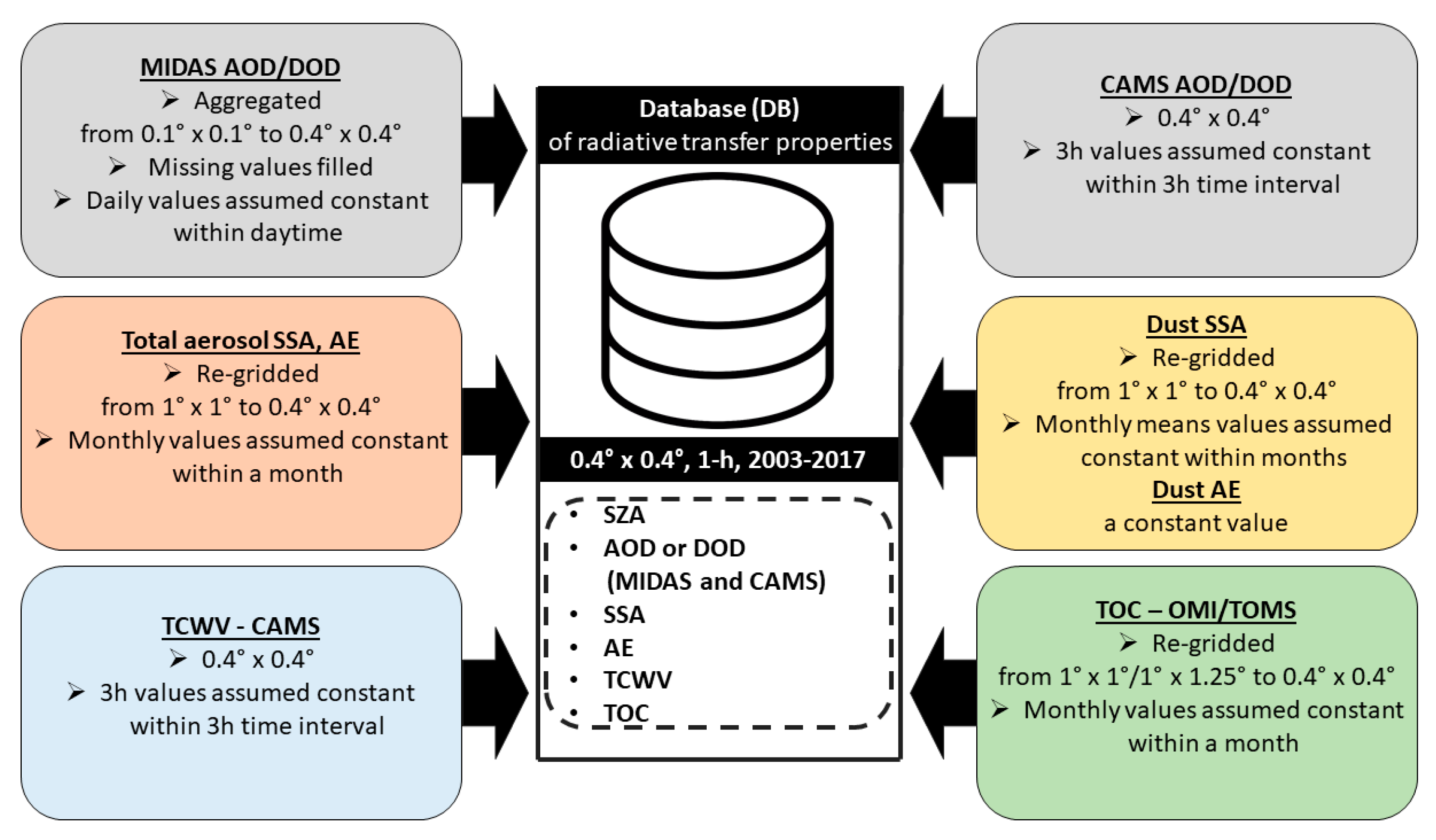

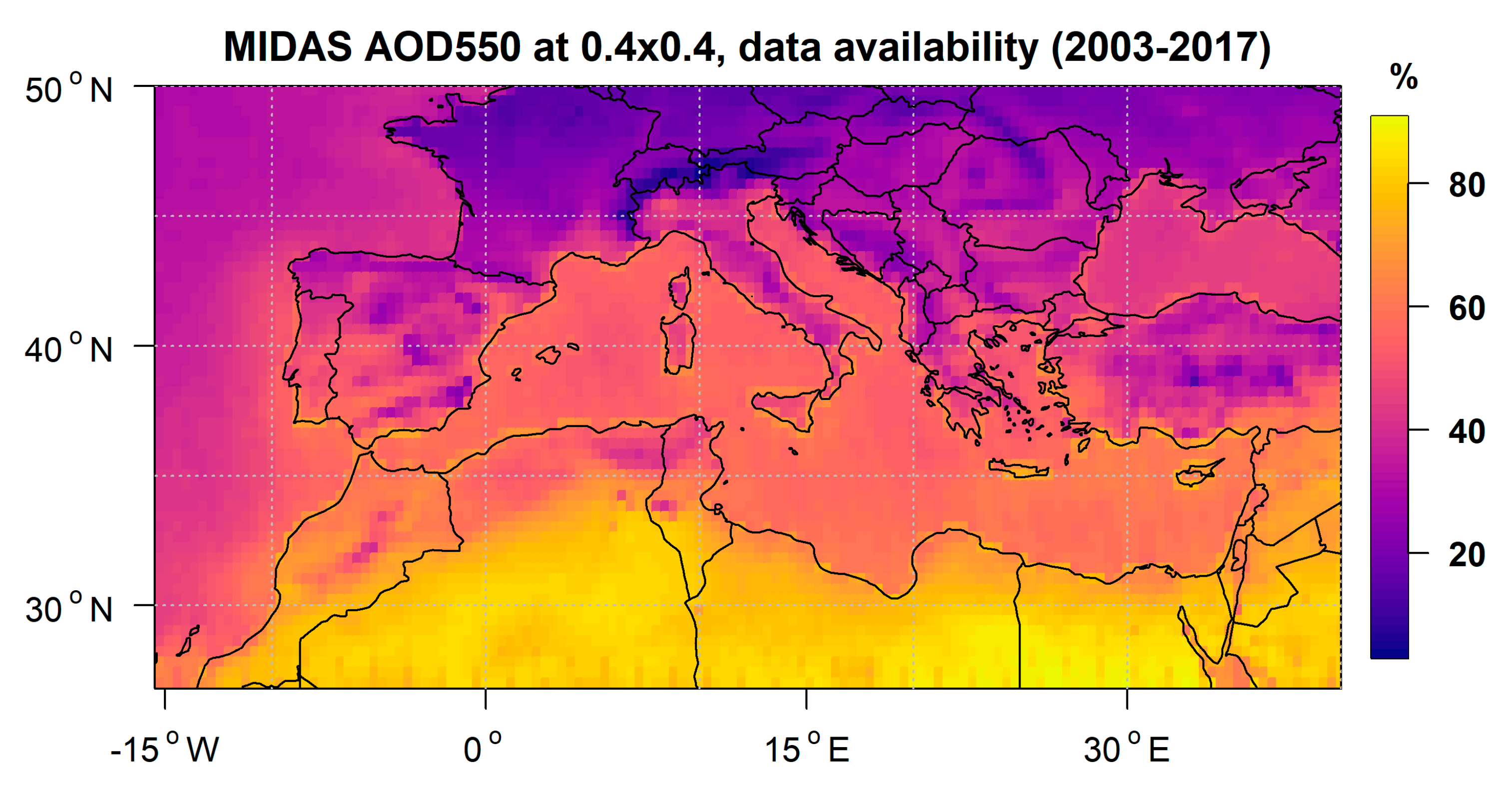
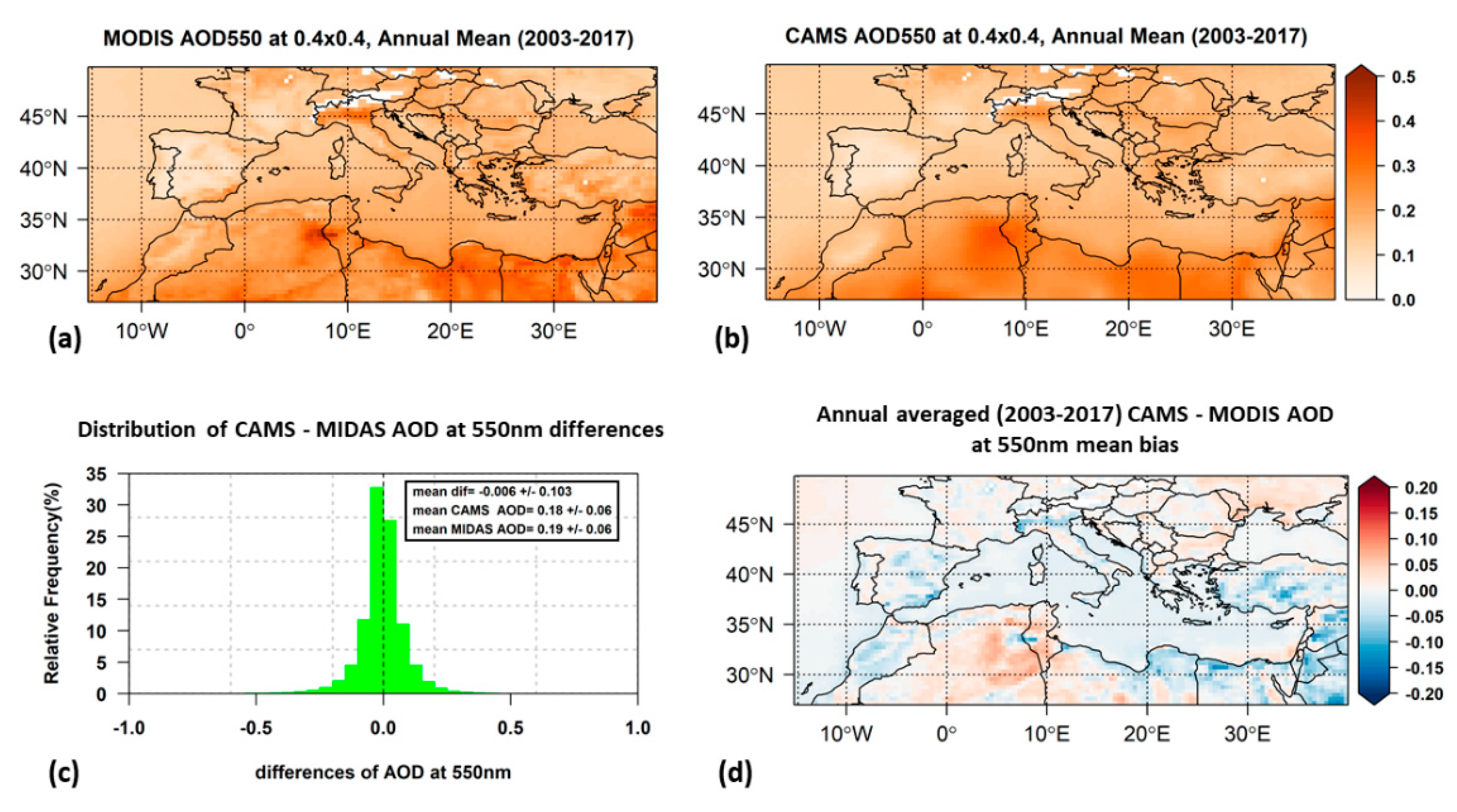
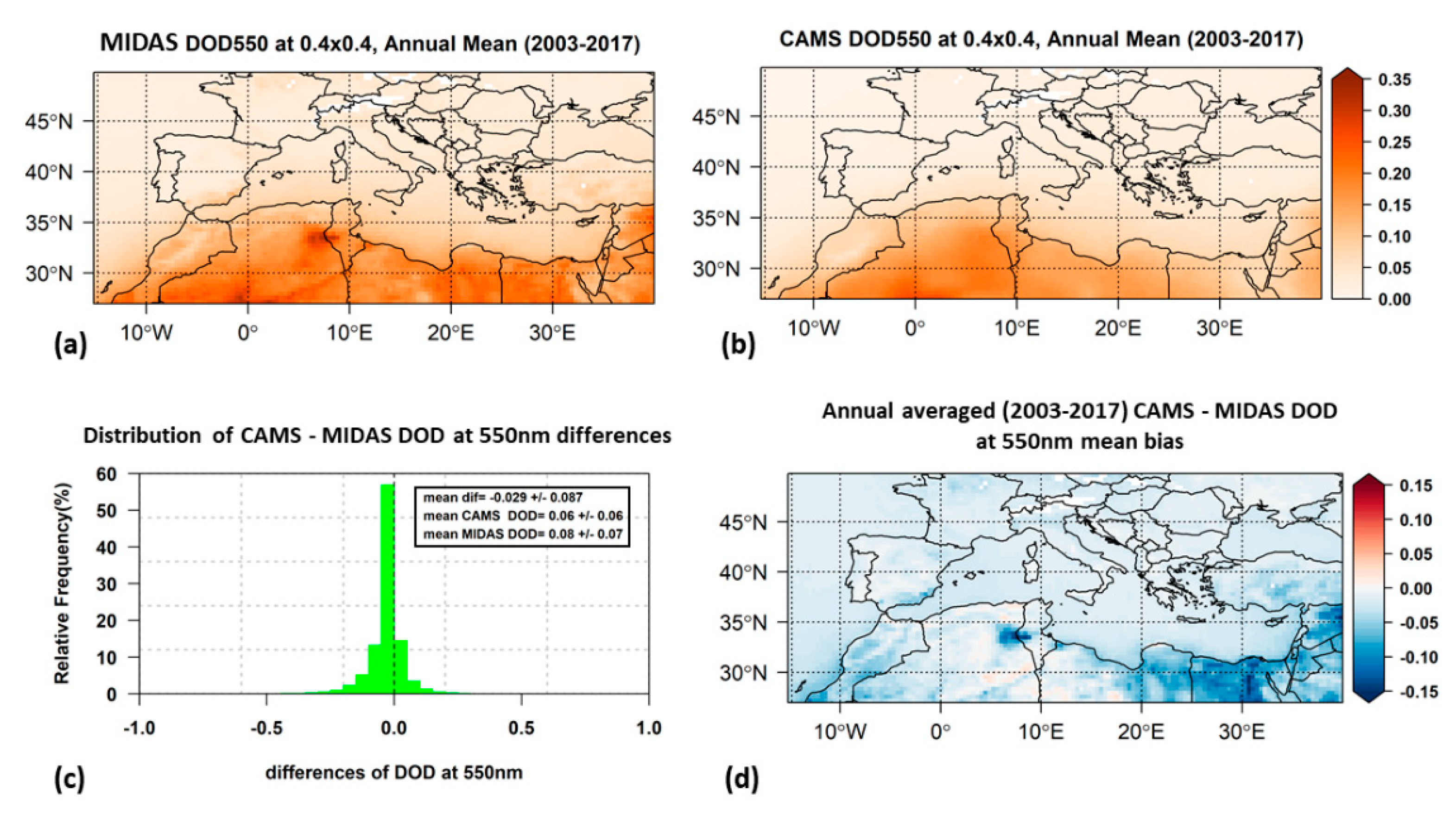




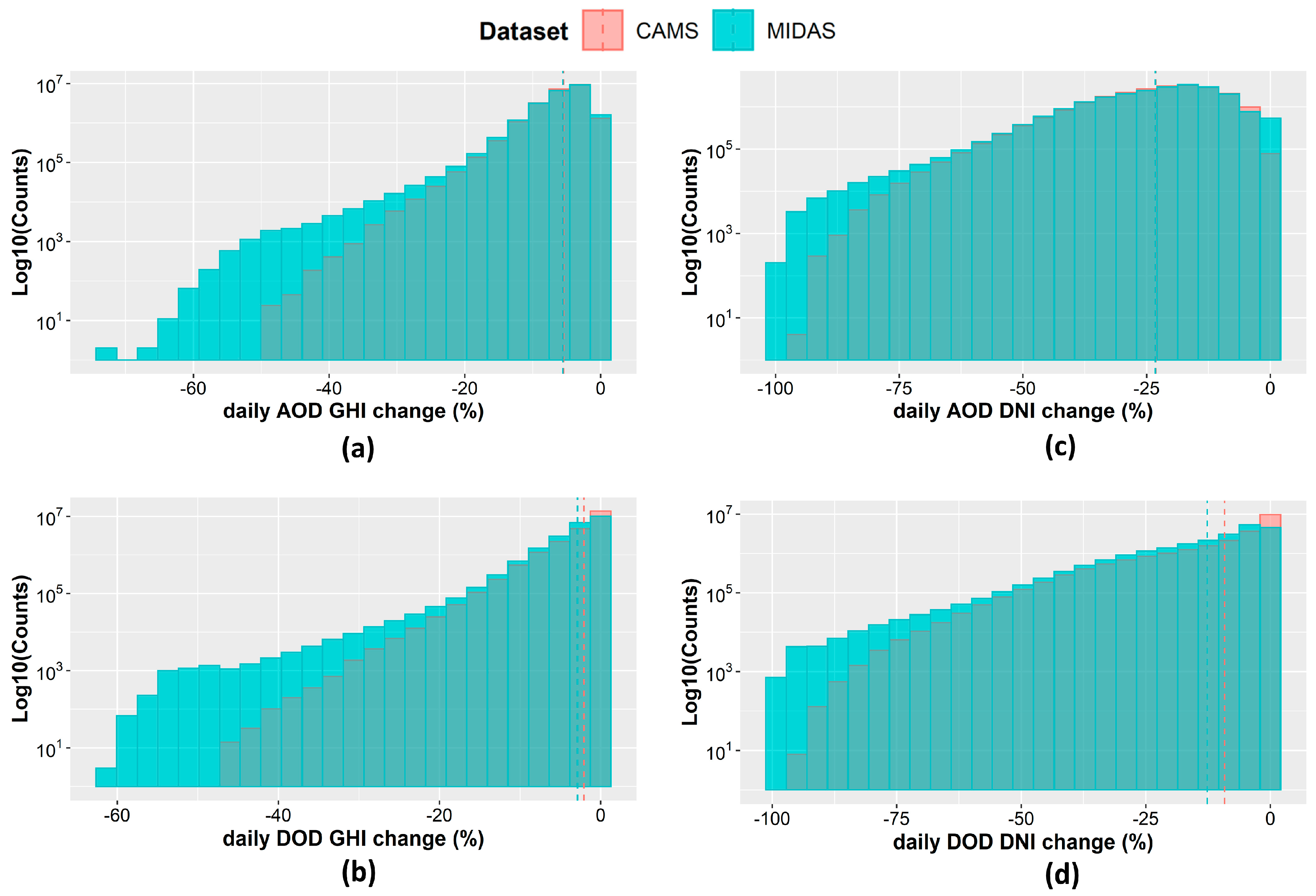
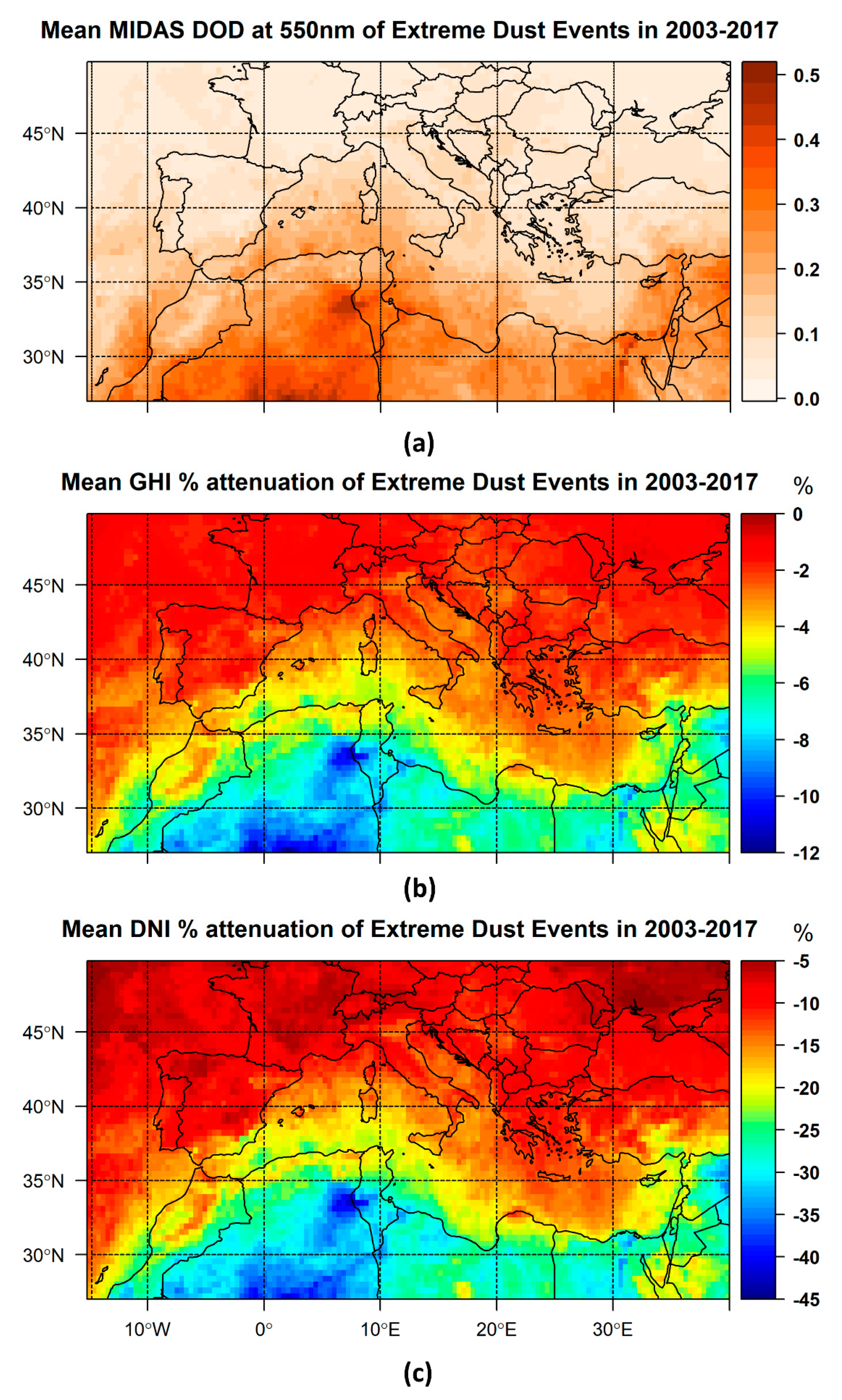
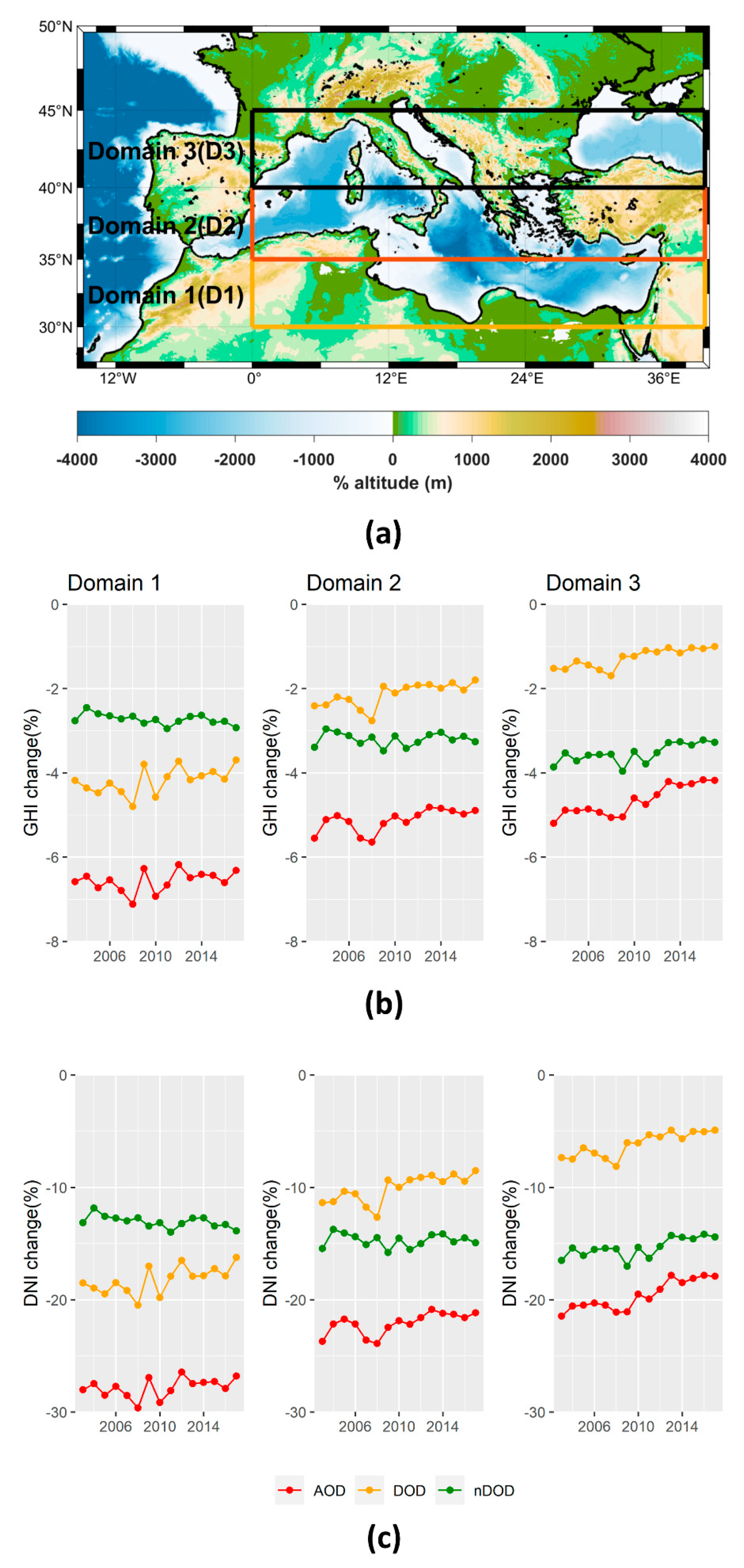

| Parameter | Description (Spatial–Temporal Resolution) | Source | Reference |
|---|---|---|---|
| Aerosol optical properties | Satellite-retrieved aerosol optical depth (AOD) (0.1° × 0.1°, 1 day) | ModIs Dust Aerosol (MIDAS) | [55] |
| Modeled AOD (0.4° × 0.4°, 3 h) | Copernicus Atmospheric Monitoring Service (CAMS) reanalysis | [61] | |
| Single scattering albedo (SSA) (1° × 1°, 1 month) | Max-Planck Aerosol Climatology (MACv2) | [63] | |
| Ångström exponent (AE) (1° × 1°, 1 month) | MACv2 | [63] | |
| Dust optical properties | Satellite-based dust optical depth (DOD) (0.1° × 0.1°, 1 day) | MIDAS | [55] |
| Modeled DOD (0.4° × 0.4°, 3 h) | CAMS reanalysis | [61] | |
| Dust SSA (DU SSA) (1° × 1°, 12 monthly means) | MACv2 | [63] | |
| Water vapor | Modeled total column water vapor (TCWV) (0.4° × 0.4°, 3 h) | CAMS reanalysis | [61] |
| Ozone | Satellite-retrieved total ozone column (TOC) (1° × 1°/1° × 1.25°, 1 day) | Ozone Monitoring Instrument (OMI) TOMS-Like Level 3 product/Earth Probe (EP) Total Ozone Mapping Spectrometer (TOMS) Level 3 version 8 product | [64,65] |
| Atmospheric Conditions | Dataset |
|---|---|
| Aerosol included | MIDAS AOD CAMS AOD |
| Dust included | MIDAS DOD |
| Aerosol-free | CAMS DOD AOD = 0 |
| AOD | DOD | |||||
|---|---|---|---|---|---|---|
| CAMS | MIDAS | Mean Bias (CAMS–MIDAS) | CAMS | MIDAS | Mean Bias (CAMS–MIDAS) | |
| Annual | ||||||
| 0.18 ± 0.06 | 0.19 ± 0.06 | −0.005 ± 0.025 | 0.06 ± 0.06 | 0.08 ± 0.07 | −0.026 ± 0.021 | |
| Seasonal | ||||||
| winter | 0.11 ± 0.05 | 0.13 ± 0.06 | −0.019 ± 0.021 | 0.03 ± 0.03 | 0.06 ± 0.05 | −0.030 ± 0.025 |
| spring | 0.21 ± 0.07 | 0.21 ± 0.07 | −0.003 ± 0.027 | 0.07 ± 0.07 | 0.11 ± 0.08 | −0.037 ± 0.024 |
| summer | 0.23 ± 0.08 | 0.23 ± 0.07 | 0.003 ± 0.038 | 0.08 ± 0.08 | 0.10 ± 0.08 | −0.019 ± 0.027 |
| autumn | 0.15 ± 0.06 | 0.16 ± 0.07 | −0.007 ± 0.028 | 0.05 ± 0.05 | 0.07 ± 0.06 | −0.023 ± 0.022 |
| AOD | DOD | |||||
|---|---|---|---|---|---|---|
| CAMS | MIDAS | Missing from CAMS Compared to MIDAS | CAMS | MIDAS | Missing from CAMS Compared to MIDAS | |
| >1 | 0.19% | 0.46% | 57% | 0.08% | 0.31% | 75% |
| >1.5 | 0.02% | 0.13% | 85% | 0.007% | 0.09% | 92% |
| >2 | 0.0015% | 0.05% | 97% | 0.0008% | 0.04% | 98% |
| >3 | 0.000009% | 0.014% | ~100% | 0 | 0.01% | 100% |
| AOD | DOD | |||
|---|---|---|---|---|
| CAMS | MIDAS | CAMS | MIDAS | |
| Annual | ||||
| −5.1 (±1.5) | −5.2 (±1.6) | −1.7 (± 1.7) | −2.4 (±1.8) | |
| Seasonal | ||||
| winter | −4.9 (±1.5) | −5.5 (±1.7) | −1.2 (± 1.2) | −2.3 (±1.7) |
| spring | −5.3 (±1.7) | −5.3 (±1.8) | −1.9 (± 1.9) | −2.9 (±2.0) |
| summer | −5.2 (±1.9) | −5.0 (±1.7) | −1.9 (± 2.1) | −2.3 (±2.0) |
| autumn | −5.0 (±1.5) | −5.1 (±1.6) | −1.5 (± 1.5) | −2.2 (±1.8) |
| AOD | DOD | |||
|---|---|---|---|---|
| CAMS | MIDAS | CAMS | MIDAS | |
| Annual | ||||
| −22.2 (±5.6) | −22.1(±5.6) | −7.5 (±6.7) | −10.7 (±7.2) | |
| Seasonal | ||||
| winter | −17.9 (±5.5) | −19.6 (±6.0) | −4.9 (±4.7) | −9.0 (±7.3) |
| spring | −23.6 (±6.2) | −23.2 (±6.7) | −8.5 (±7.6) | −12.7 (±7.9) |
| summer | −24.0 (±7.3) | −23.3 (±6.5) | −9.1 (±8.8) | −11.2 (±8.2) |
| autumn | −20.5 (±5.8) | −20.5 (±6.2) | −6.4 (±6.1) | −9.4 (±7.2) |
| GHI (MJ/m2) | DNI (MJ/m2) | |
|---|---|---|
| Annual | ||
| 7486 (±630) | 9899 (±616) | |
| Seasonal | ||
| winter | 1074 (±273) | 1972 (±231) |
| spring | 2287 (±116) | 2747 (±247) |
| summer | 2612 (±57) | 2931 (±299) |
| autumn | 1512 (±219) | 2249 (±143) |
Publisher’s Note: MDPI stays neutral with regard to jurisdictional claims in published maps and institutional affiliations. |
© 2022 by the authors. Licensee MDPI, Basel, Switzerland. This article is an open access article distributed under the terms and conditions of the Creative Commons Attribution (CC BY) license (https://creativecommons.org/licenses/by/4.0/).
Share and Cite
Papachristopoulou, K.; Fountoulakis, I.; Gkikas, A.; Kosmopoulos, P.G.; Nastos, P.T.; Hatzaki, M.; Kazadzis, S. 15-Year Analysis of Direct Effects of Total and Dust Aerosols in Solar Radiation/Energy over the Mediterranean Basin. Remote Sens. 2022, 14, 1535. https://doi.org/10.3390/rs14071535
Papachristopoulou K, Fountoulakis I, Gkikas A, Kosmopoulos PG, Nastos PT, Hatzaki M, Kazadzis S. 15-Year Analysis of Direct Effects of Total and Dust Aerosols in Solar Radiation/Energy over the Mediterranean Basin. Remote Sensing. 2022; 14(7):1535. https://doi.org/10.3390/rs14071535
Chicago/Turabian StylePapachristopoulou, Kyriakoula, Ilias Fountoulakis, Antonis Gkikas, Panagiotis G. Kosmopoulos, Panagiotis T. Nastos, Maria Hatzaki, and Stelios Kazadzis. 2022. "15-Year Analysis of Direct Effects of Total and Dust Aerosols in Solar Radiation/Energy over the Mediterranean Basin" Remote Sensing 14, no. 7: 1535. https://doi.org/10.3390/rs14071535
APA StylePapachristopoulou, K., Fountoulakis, I., Gkikas, A., Kosmopoulos, P. G., Nastos, P. T., Hatzaki, M., & Kazadzis, S. (2022). 15-Year Analysis of Direct Effects of Total and Dust Aerosols in Solar Radiation/Energy over the Mediterranean Basin. Remote Sensing, 14(7), 1535. https://doi.org/10.3390/rs14071535










